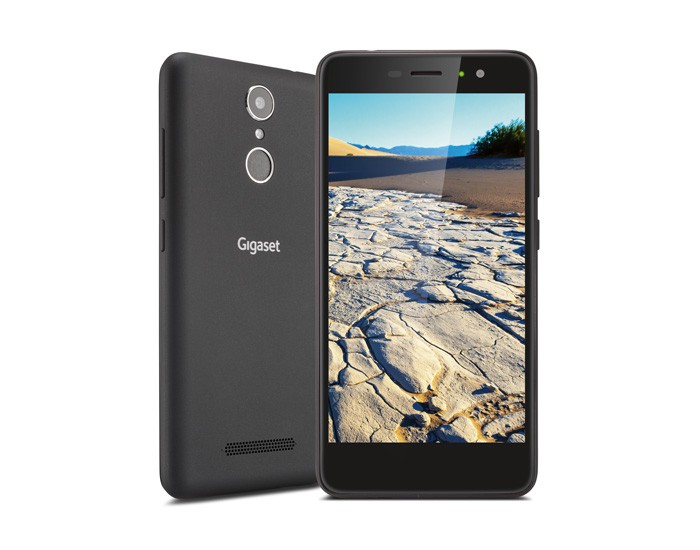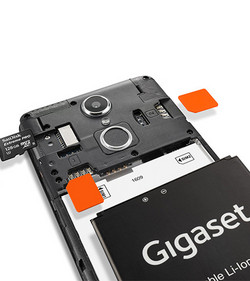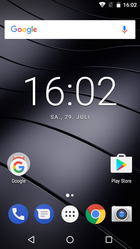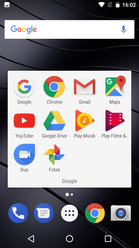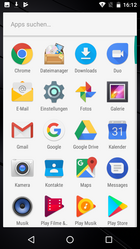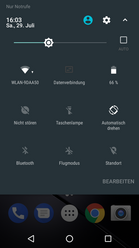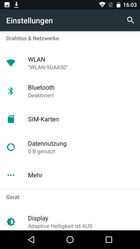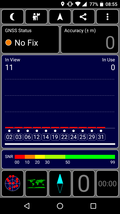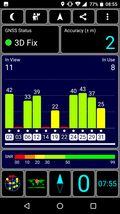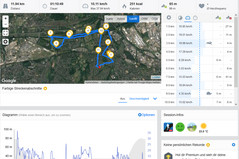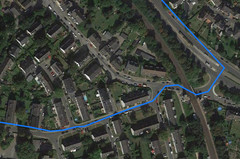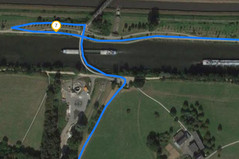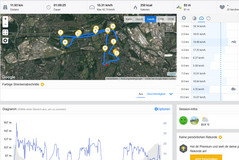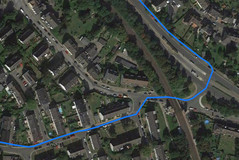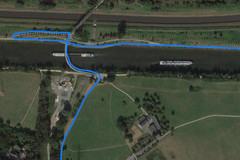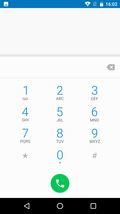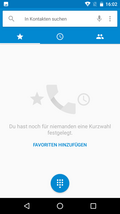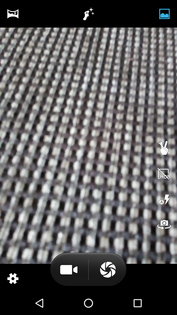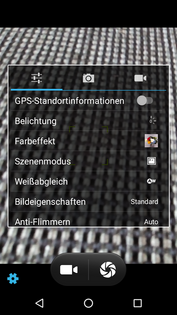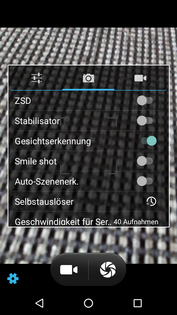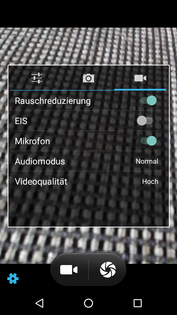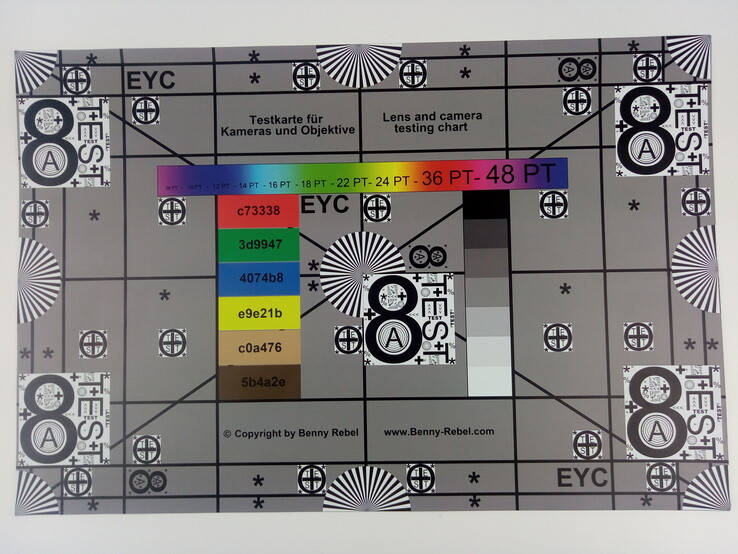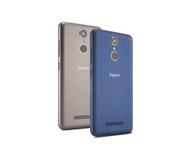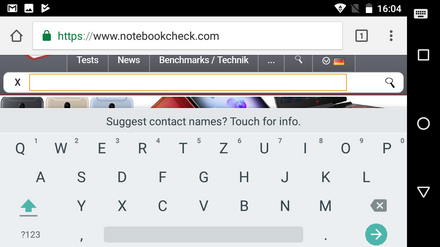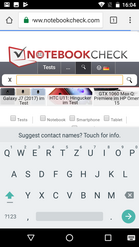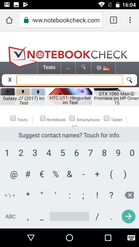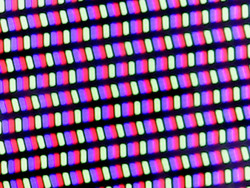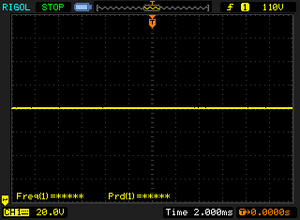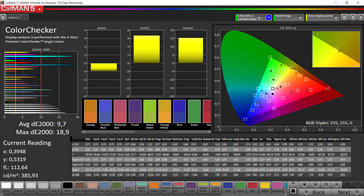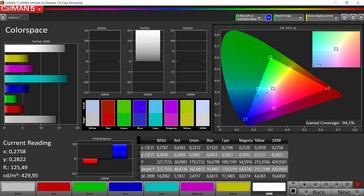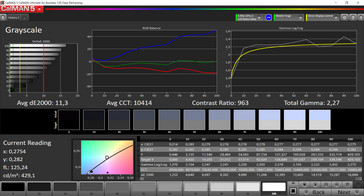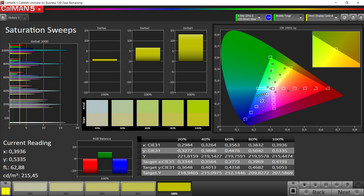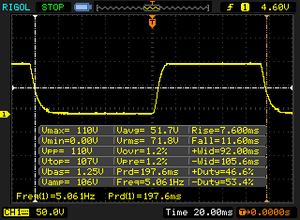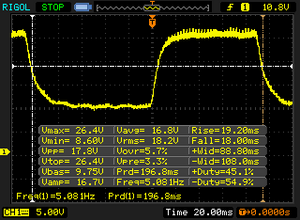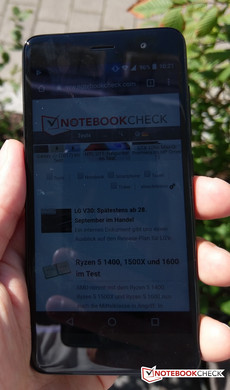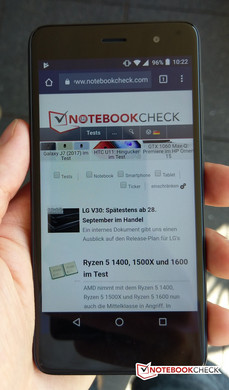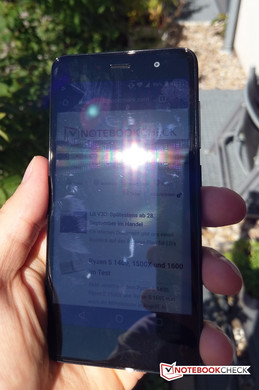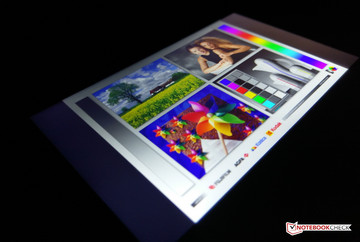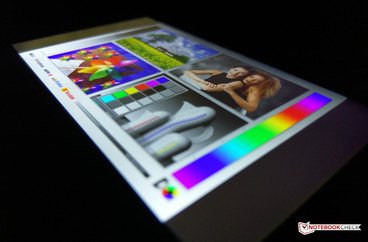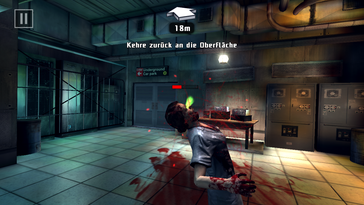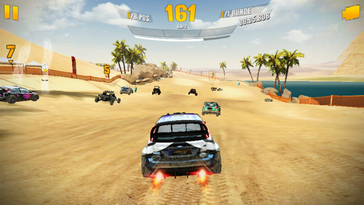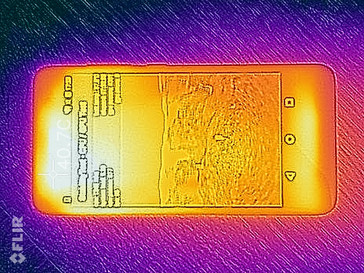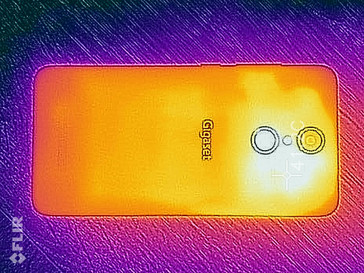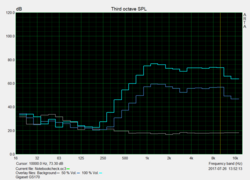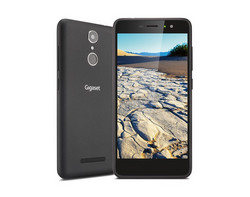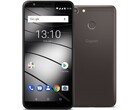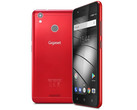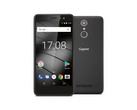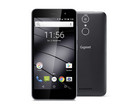Gigaset GS170 Smartphone Review

For the original German review, see here.
With the Gigaset GS170, the manufacturer brings a slightly improved version of the 2016 model to the market. The successor of the Gigaset GS160 that we tested earlier is still equipped with a 5-inch IPS display with an HD resolution of 1280x720 pixels. The MediaTek MT6737 low-budget quad-core processor is also on the equipment list, but now it is supported by 2 GB of working memory. The internal flash storage of the LTE smartphone holds 16 GB and can be expanded by up to 128 GB, without losing the dual-SIM functionality.
Gigaset asks 150 Euros (~$177) as the recommended retail price for its entry-level model. With this, the manufacturer positions the GS170 in a very competitive smartphone segment. Accordingly, the list of the possible competitors is long. For our review, we use the comparisons of the Moto G4 Play and C2 Lenovo devices, the Coolpad Modena 2, and the Blade A510 and Blade V7 Lite ZTE smartphones. We also include the UMi Max, the UleFone Metal, and the Blackview P2 as imported devices.
Case
Thanks to the 2.5D edge, the glass front of the Gigaset GS170 is set slightly rounded into the case. The bezels around the 5-inch display are relatively wide, which is reflected in the display to surface ratio of just 67%. Yet due to the relatively compact measurements of 144 x 72 mm (~5.7 x 2.8 in), the 9.5-mm (0.37 in) thick smartphone fits into the hand comfortably.
The surface of the removable plastic back cover is slightly rough, which visibly minimizes annoying fingerprints. However, the case of the GS170 does not ooze a high-value feeling. After taking off the back, the 16 GB internal storage can be expanded via microSD card, and the battery can be exchanged. The two card slots are also below the cover.
The on/off button and the two keys for the volume adjustment on the right side of the case have a good pressure point and are well-built. The stability of the case also makes a sturdy impression.
Features
The internal eMMC storage of the Gigaset smartphone has a capacity of 16 GB, leaving only 10.3 GB in the delivery state available for the user. Apps can be moved to the external storage via a formatted microSDXC card (up to 128 GB. As well as the SD card slot, the GS170 also has two slots for microSIM cards. In addition, the entry-level device has a status LED for missed calls or new messages, a fingerprint sensor, and an FM radio. Using Voice over LTE (VoLTE) is also possible and wireless transfer of the display contents to external monitors is also supported.
The Gigaset GS170 has a Micro-USB connector of the 2.0 standard. This works only for charging the device, since the USB port does not recognize peripheral devices such as USB sticks or external keyboards.
Software
For the system software, the German manufacturer uses the quite current Google Android 7.0 "Nougat" version. At the time of our test, the entry-level smartphone only has the security patch level from May 2017.
The Gigaset user interface closely follows Google's stock Android. However, the GS170 has additional software features. The fingerprint sensor can be used for functions such as scrolling, or apps can be opened by drawing particular symbols with your fingers on the display. For example, the letter "W" opens WhatsApp. Up to 8 predefined gestures can be used on the Gigaset GS170.
Fortunately, there is hardly any pre-installed bloatware that cannot be uninstalled almost completely.
Communication and GPS
For wireless communication between mobile devices, the Gigaset GS170 has Bluetooth version 4.0. Furthermore, the features include WLAN according to the 802.11 b/g/n standard.
The WLAN module has good reception qualities and at barely -35 dBm in close proximity to the router (Telekom Speedport, W921V), the damping is low. At 50 Mbit/s (sending) and 49 Mbit/s (receiving) from 1 m (~3.3 ft) distance, the average rates for data transfer to our reference router (Linksys EA8500) are on a typical level for entry-level devices and barely better than in the predecessor.
The GS170 communicates with mobile networks via GSM (quad-band), UMTS (dual-band), and LTE in the frequencies of 800, 1800, 2100, and 2600 MHz. Due to the dual-SIM capabilities, up to two microSIM cards can be used in parallel. Both slots support using the LTE net at up to 150 Mbit/s in the download.
| Networking | |
| iperf3 transmit AX12 | |
| HTC U11 | |
| UMI Max | |
| Blackview P2 | |
| Lenovo C2 | |
| Gigaset GS170 | |
| Coolpad Modena 2 | |
| Gigaset GS160 | |
| ZTE Blade A510 | |
| iperf3 receive AX12 | |
| HTC U11 | |
| UMI Max | |
| Blackview P2 | |
| Lenovo C2 | |
| Gigaset GS170 | |
| ZTE Blade A510 | |
| Coolpad Modena 2 | |
| Gigaset GS160 | |
The position is located via the GPS satellite system. Outdoors, the position was located very quickly with an accuracy of up to 2 meters (~6.6 ft). In enclosed spaces, there was not sufficient satellite signal to enable locating the position in our test. During our GPS test, we observed hardly any discrepancies (10 m, ~33 ft) between the built-in GPS module of the Gigaset GS170 and the professional Garmin Edge 500 reference device on the 12-km (~7.5 miles) test route. The GPS performance is excellent for a device in this price range.
Telephone and Call Quality
The call quality in the entry-level smartphone is satisfactory, even though the earpiece reproduces the voices with a slight noise. The maximum volume leads to the conversation partner to be easily understandable, and we were also understood well. There were no other disturbing noises in the earpiece.
Cameras
The camera module in the back has a resolution of 13 MP. In good light conditions, the pictures can compel with a high-contrast color reproduction. The sharpness achieved by the automatic focus is good, but decreasing slightly towards the edges. Due the low aperture of f/2.2, comparatively little light hits the image sensor, so the brightness in the images is barely sufficient. The dynamic range tends to be too small, causing the images to become too dark in widely varying light conditions.
If the light conditions become worse, strong image noise begins to occur. The very low image brightness then makes the image contents hardly recognizable.
In the front of the device is a 5-MP camera. The quality is sufficient for selfies and video calling. Videos can be recorded in 720p quality at 30 FPS.
Accessories and Warranty
Besides a modular 5-watt charger (5V, 1A), a USB cable and the usual booklets are included in the delivery contents.
According to the included warranty card, the manufacturer offers a 24-month warranty from the date of purchase. Please see our Guarantees, Return policies and Warranties FAQ for country-specific information.
Input Devices and Operation
The navigation of the GS170 is performed with the usual Android onscreen keys. The capacitive multi-touchscreen reacts reliably up to the edges of the display to inputs with up to five fingers. Moreover, the glass surface has good sliding characteristics. We negatively note the slow reaction time of the display. Subjectively, it feels very long.
The recognition rate of the active fingerprint sensor on the back could be better. Often the finger must be repositioned on the sensor for it to be recognized. The time it takes the device to wake up from standby is also relatively long. However, the performance of the fingerprint sensor is sufficient for this price range.
Display
As in the GS160 before, the IPS display of the GS170 offers a native HD resolution of 1280x720 pixels in a 5-inch diagonal, leading to a pixel density of about 294 PPI.
Even though at a maximum of 432 cd/m², the panel brightness is sufficient for most usage scenarios, it is exceeded by some of the competition. In the measurement of evenly distributed bright and dark areas (APL-50), we detected an average brightness of only 349 cd/m².
| |||||||||||||||||||||||||
Brightness Distribution: 92 %
Center on Battery: 418 cd/m²
Contrast: 929:1 (Black: 0.45 cd/m²)
ΔE ColorChecker Calman: 9.7 | ∀{0.5-29.43 Ø4.78}
ΔE Greyscale Calman: 11.3 | ∀{0.09-98 Ø5}
Gamma: 2.27
CCT: 10414 K
| Gigaset GS170 IPS, 1280x720, 5" | Gigaset GS160 IPS, 1280x720, 5" | Lenovo Moto G4 Play IPS, 1280x720, 5" | Lenovo C2 IPS, 1280x720, 5" | ZTE Blade A510 IPS, 1280x720, 5" | ZTE Blade V7 Lite IPS, 1280x720, 5" | Coolpad Modena 2 IPS, 1280x720, 5.5" | UMI Max IPS, 1920x1080, 5.5" | Ulefone Metal IPS, 1280x720, 5" | Blackview P2 IPS, 1920x1080, 5.5" | HTC U11 Super LCD5, 2560x1440, 5.5" | |
|---|---|---|---|---|---|---|---|---|---|---|---|
| Screen | 9% | 18% | 23% | 20% | 21% | 8% | 39% | -3% | 29% | 41% | |
| Brightness middle (cd/m²) | 418 | 489 17% | 412 -1% | 458 10% | 528 26% | 312 -25% | 482 15% | 522 25% | 312 -25% | 424 1% | 482 15% |
| Brightness (cd/m²) | 418 | 479 15% | 414 -1% | 449 7% | 524 25% | 302 -28% | 468 12% | 498 19% | 315 -25% | 420 0% | 472 13% |
| Brightness Distribution (%) | 92 | 95 3% | 94 2% | 92 0% | 94 2% | 79 -14% | 86 -7% | 86 -7% | 87 -5% | 85 -8% | 90 -2% |
| Black Level * (cd/m²) | 0.45 | 0.55 -22% | 0.42 7% | 0.35 22% | 0.62 -38% | 0.15 67% | 0.63 -40% | 0.23 49% | 0.56 -24% | 0.15 67% | 0.33 27% |
| Contrast (:1) | 929 | 889 -4% | 981 6% | 1309 41% | 852 -8% | 2080 124% | 765 -18% | 2270 144% | 557 -40% | 2827 204% | 1461 57% |
| Colorchecker dE 2000 * | 9.7 | 8.3 14% | 5.6 42% | 6.5 33% | 5.2 46% | 8.2 15% | 6.5 33% | 6.9 29% | 6.8 30% | 9.5 2% | 3.2 67% |
| Colorchecker dE 2000 max. * | 18.9 | 14.4 24% | 9.7 49% | 11.7 38% | 8.7 54% | 16.5 13% | 12.4 34% | 12.3 35% | 14 26% | 19.7 -4% | 5.4 71% |
| Greyscale dE 2000 * | 11.3 | 8.7 23% | 6.9 39% | 7.7 32% | 5.7 50% | 9.2 19% | 7.3 35% | 9.2 19% | 7.1 37% | 14.5 -28% | 2.2 81% |
| Gamma | 2.27 97% | 2.08 106% | 2.4 92% | 2.15 102% | 1.99 111% | 2.29 96% | 1.91 115% | 2.38 92% | 2.77 79% | 2.28 96% | 2.22 99% |
| CCT | 10414 62% | 9034 72% | 8422 77% | 8518 76% | 6631 98% | 9017 72% | 7249 90% | 8687 75% | 7402 88% | 10840 60% | 6581 99% |
* ... smaller is better
Screen Flickering / PWM (Pulse-Width Modulation)
| Screen flickering / PWM not detected | |||
In comparison: 53 % of all tested devices do not use PWM to dim the display. If PWM was detected, an average of 8108 (minimum: 5 - maximum: 343500) Hz was measured. | |||
The combination of the display brightness and a black value of 0.45 cd/m² results in a contrast ratio of 1:929, which is above the manufacturer's specifications of 1:800. Our APL-50 measurement qualifies the higher contrast though. Even though the black value remains constant in evenly distributed light and dark image areas, the contrast drops to 1:776.
Compared to the competition, the display analysis with a photo spectrometer and the CalMAN software shows rather high deviations in the color (9.7) and grayscale display (11.3). Furthermore, the display's color temperature of 10414 Kelvin is calibrated clearly too cool. In practice this results in a visible blue tint.
Display Response Times
| ↔ Response Time Black to White | ||
|---|---|---|
| 19.2 ms ... rise ↗ and fall ↘ combined | ↗ 7.6 ms rise | |
| ↘ 11.6 ms fall | ||
| The screen shows good response rates in our tests, but may be too slow for competitive gamers. In comparison, all tested devices range from 0.1 (minimum) to 240 (maximum) ms. » 41 % of all devices are better. This means that the measured response time is similar to the average of all tested devices (20.2 ms). | ||
| ↔ Response Time 50% Grey to 80% Grey | ||
| 37.2 ms ... rise ↗ and fall ↘ combined | ↗ 19.2 ms rise | |
| ↘ 18 ms fall | ||
| The screen shows slow response rates in our tests and will be unsatisfactory for gamers. In comparison, all tested devices range from 0.165 (minimum) to 636 (maximum) ms. » 53 % of all devices are better. This means that the measured response time is worse than the average of all tested devices (31.6 ms). | ||
Outdoors, the liquid crystal display of the Gigaset GS170 works convincingly. However, in direct sun, the contents are hard to read. As typical for IPS displays, the viewing angles are on a good level, and the contents are displayed with relatively good color accuracy even from very steep viewing angles.
Performance
The SoC (System-on-a-Chip) used in the GS170 is an entry-level MediaTek MT6737 processor. It has four CPU cores based on the 64-bit-capable Cortex-A53 architecture. The MT6737 is accompanied by an ARM Mali-T720 (MP2) graphics unit and 2 GB RAM.
The subjective system performance is rather below average. Although the system runs relatively smoothly in everyday life, there are often delays. Opening and closing of apps is also slow. However, in the benchmarks the Gigaset GS170 can keep up with the competition quite easily. Compared to the predecessor, the values of the MediaTek SoC have even slightly improved.
| AnTuTu v6 - Total Score (sort by value) | |
| Gigaset GS170 | |
| Gigaset GS160 | |
| ZTE Blade V7 Lite | |
| Coolpad Modena 2 | |
| Lenovo C2 | |
| ZTE Blade A510 | |
| UMI Max | |
| Ulefone Metal | |
| Blackview P2 | |
| HTC U11 | |
| PCMark for Android | |
| Work performance score (sort by value) | |
| Gigaset GS170 | |
| Gigaset GS160 | |
| Coolpad Modena 2 | |
| Lenovo C2 | |
| ZTE Blade A510 | |
| UMI Max | |
| Ulefone Metal | |
| Blackview P2 | |
| HTC U11 | |
| Work 2.0 performance score (sort by value) | |
| Gigaset GS170 | |
| ZTE Blade A510 | |
| Blackview P2 | |
| HTC U11 | |
| Geekbench 4.4 | |
| 64 Bit Single-Core Score (sort by value) | |
| Gigaset GS170 | |
| Blackview P2 | |
| HTC U11 | |
| 64 Bit Multi-Core Score (sort by value) | |
| Gigaset GS170 | |
| Blackview P2 | |
| HTC U11 | |
| Compute RenderScript Score (sort by value) | |
| Blackview P2 | |
| HTC U11 | |
| GFXBench (DX / GLBenchmark) 2.7 | |
| T-Rex Onscreen (sort by value) | |
| Gigaset GS170 | |
| Gigaset GS160 | |
| ZTE Blade V7 Lite | |
| Coolpad Modena 2 | |
| Lenovo C2 | |
| ZTE Blade A510 | |
| UMI Max | |
| Ulefone Metal | |
| Blackview P2 | |
| HTC U11 | |
| 1920x1080 T-Rex Offscreen (sort by value) | |
| Gigaset GS170 | |
| Gigaset GS160 | |
| ZTE Blade V7 Lite | |
| Coolpad Modena 2 | |
| Lenovo C2 | |
| ZTE Blade A510 | |
| UMI Max | |
| Ulefone Metal | |
| Blackview P2 | |
| HTC U11 | |
| GFXBench 3.0 | |
| on screen Manhattan Onscreen OGL (sort by value) | |
| Gigaset GS170 | |
| Gigaset GS160 | |
| ZTE Blade V7 Lite | |
| Coolpad Modena 2 | |
| Lenovo C2 | |
| ZTE Blade A510 | |
| UMI Max | |
| Ulefone Metal | |
| Blackview P2 | |
| HTC U11 | |
| 1920x1080 1080p Manhattan Offscreen (sort by value) | |
| Gigaset GS170 | |
| Gigaset GS160 | |
| ZTE Blade V7 Lite | |
| Coolpad Modena 2 | |
| Lenovo C2 | |
| UMI Max | |
| Ulefone Metal | |
| Blackview P2 | |
| HTC U11 | |
| GFXBench 3.1 | |
| on screen Manhattan ES 3.1 Onscreen (sort by value) | |
| Gigaset GS170 | |
| Gigaset GS160 | |
| ZTE Blade V7 Lite | |
| Coolpad Modena 2 | |
| Lenovo C2 | |
| ZTE Blade A510 | |
| UMI Max | |
| Ulefone Metal | |
| Blackview P2 | |
| HTC U11 | |
| 1920x1080 Manhattan ES 3.1 Offscreen (sort by value) | |
| Gigaset GS170 | |
| Gigaset GS160 | |
| ZTE Blade V7 Lite | |
| Coolpad Modena 2 | |
| Lenovo C2 | |
| ZTE Blade A510 | |
| UMI Max | |
| Ulefone Metal | |
| Blackview P2 | |
| HTC U11 | |
| GFXBench | |
| on screen Car Chase Onscreen (sort by value) | |
| UMI Max | |
| Blackview P2 | |
| HTC U11 | |
| 1920x1080 Car Chase Offscreen (sort by value) | |
| UMI Max | |
| Blackview P2 | |
| HTC U11 | |
In contrast to the system performance, the browser speed with the Chrome browser is satisfactory and rather good for the price range. Just like the synthetic benchmarks, the Chinese competition consisting of the UMI Max, the Blackview P2, and the Ulefone Metal, clearly do better in the browser performance.
| JetStream 1.1 - Total Score | |
| HTC U11 | |
| UMI Max | |
| Blackview P2 | |
| Ulefone Metal | |
| Lenovo Moto G4 Play | |
| Gigaset GS160 | |
| Gigaset GS170 | |
| Lenovo C2 | |
| Coolpad Modena 2 | |
| ZTE Blade A510 | |
| ZTE Blade V7 Lite | |
| Octane V2 - Total Score | |
| HTC U11 | |
| UMI Max | |
| Blackview P2 | |
| Lenovo Moto G4 Play | |
| Ulefone Metal | |
| Gigaset GS160 | |
| Gigaset GS170 | |
| Lenovo C2 | |
| ZTE Blade A510 | |
| Coolpad Modena 2 | |
| ZTE Blade V7 Lite | |
| Mozilla Kraken 1.1 - Total | |
| Coolpad Modena 2 | |
| ZTE Blade V7 Lite | |
| ZTE Blade A510 | |
| Gigaset GS170 | |
| Lenovo C2 | |
| Gigaset GS160 | |
| Ulefone Metal | |
| Blackview P2 | |
| Lenovo Moto G4 Play | |
| UMI Max | |
| HTC U11 | |
* ... smaller is better
Besides the CPU, the speed of the internal storage also plays an important role in the subjective system performance. For eMMC storage, the access rates of the GS170 are good, but compared to the modern UFS storage of the HTC U11 it is quite slow.
The integrated microSD card slot is also relatively slow. We tested its speed with our Toshiba Exceria Pro M501 (UHS-II, Class 3) reference storage card. At 37 MB/s (reading) and 21 MB/s (writing), the performance of the slot was at the level of other entry devices.
| Gigaset GS170 | Gigaset GS160 | Lenovo Moto G4 Play | Lenovo C2 | ZTE Blade A510 | ZTE Blade V7 Lite | Coolpad Modena 2 | UMI Max | Ulefone Metal | Blackview P2 | HTC U11 | |
|---|---|---|---|---|---|---|---|---|---|---|---|
| AndroBench 3-5 | -10% | 59% | -43% | -43% | -8% | -10% | 20% | 11% | 38% | 315% | |
| Sequential Read 256KB (MB/s) | 197.9 | 200.5 1% | 144.1 -27% | 120.7 -39% | 111.9 -43% | 187.3 -5% | 147 -26% | 257.9 30% | 228.8 16% | 264.8 34% | 717 262% |
| Sequential Write 256KB (MB/s) | 44.79 | 46.6 4% | 43.95 -2% | 8 -82% | 9.94 -78% | 70.3 57% | 42.56 -5% | 69.5 55% | 39.91 -11% | 133.8 199% | 206.4 361% |
| Random Read 4KB (MB/s) | 18.34 | 18.5 1% | 17.9 -2% | 14.5 -21% | 14.03 -24% | 18.24 -1% | 23.03 26% | 26.66 45% | 22.18 21% | 22.07 20% | 91.4 398% |
| Random Write 4KB (MB/s) | 10.45 | 6.8 -35% | 28.31 171% | 4.7 -55% | 4.69 -55% | 8.26 -21% | 6.79 -35% | 10.91 4% | 7.87 -25% | 9.54 -9% | 80 666% |
| Sequential Read 256KB SDCard (MB/s) | 37.41 | 30.71 -18% | 65.5 75% | 24.2 -35% | 25.55 -32% | 22.77 -39% | 35.59 -5% | 36.64 -2% | 49.6 33% | 34.26 -8% | 68.8 84% |
| Sequential Write 256KB SDCard (MB/s) | 21.34 | 19.19 -10% | 51.1 139% | 16.1 -25% | 16.5 -23% | 12.62 -41% | 18.25 -14% | 18.07 -15% | 27.6 29% | 19.61 -8% | 46.25 117% |
Games
The Mali-T720 (MP2) graphics unit integrated into the MediaTek MT6737 has two clusters and a maximum clock speed of 650 MHz. In our gaming tests, devices with this SoC achieve maximum frame rates of 28 fps. With this, the GPU performance is insufficient to display demanding games such as "Dead Trigger 2" or "Asphalt Xtreme" smoothly. Furthermore, there are often considerable drops in the frame rates during gaming operation.
The touchscreen as well as the position sensor of the Gigaset GS170 work without a hitch in our test.
Emissions
Temperature
(+) The maximum temperature on the upper side is 37.3 °C / 99 F, compared to the average of 35.2 °C / 95 F, ranging from 21.9 to 247 °C for the class Smartphone.
(+) The bottom heats up to a maximum of 37.8 °C / 100 F, compared to the average of 34 °C / 93 F
(±) In idle usage, the average temperature for the upper side is 33.5 °C / 92 F, compared to the device average of 32.9 °C / 91 F.
Speaker
The speaker positioned on the back is sufficiently powerful at 84 dB(A). The sound reproduction is appropriate for the price range and sounds tinny with increasing volume. In the audible range between 100 and 16000 Hz, the sound of the GS170 is not very linear - the bass is not audible.
Alternatively, for a balanced sound experience the 3.5-mm port can be used.
Gigaset GS170 audio analysis
(+) | speakers can play relatively loud (84.4 dB)
Bass 100 - 315 Hz
(-) | nearly no bass - on average 40.3% lower than median
(+) | bass is linear (5.9% delta to prev. frequency)
Mids 400 - 2000 Hz
(±) | reduced mids - on average 9.1% lower than median
(±) | linearity of mids is average (11.5% delta to prev. frequency)
Highs 2 - 16 kHz
(±) | higher highs - on average 5.6% higher than median
(+) | highs are linear (2.1% delta to prev. frequency)
Overall 100 - 16.000 Hz
(-) | overall sound is not linear (31.4% difference to median)
Compared to same class
» 81% of all tested devices in this class were better, 3% similar, 16% worse
» The best had a delta of 11%, average was 35%, worst was 134%
Compared to all devices tested
» 90% of all tested devices were better, 2% similar, 8% worse
» The best had a delta of 4%, average was 24%, worst was 134%
UMI Max audio analysis
(+) | speakers can play relatively loud (82.4 dB)
Bass 100 - 315 Hz
(-) | nearly no bass - on average 35.9% lower than median
(±) | linearity of bass is average (10.1% delta to prev. frequency)
Mids 400 - 2000 Hz
(±) | reduced mids - on average 7.4% lower than median
(±) | linearity of mids is average (8.7% delta to prev. frequency)
Highs 2 - 16 kHz
(±) | higher highs - on average 5% higher than median
(±) | linearity of highs is average (8.9% delta to prev. frequency)
Overall 100 - 16.000 Hz
(-) | overall sound is not linear (31.8% difference to median)
Compared to same class
» 82% of all tested devices in this class were better, 2% similar, 16% worse
» The best had a delta of 11%, average was 35%, worst was 134%
Compared to all devices tested
» 91% of all tested devices were better, 2% similar, 8% worse
» The best had a delta of 4%, average was 24%, worst was 134%
Lenovo Moto G4 Play audio analysis
(-) | not very loud speakers (67.6 dB)
Bass 100 - 315 Hz
(-) | nearly no bass - on average 24% lower than median
(±) | linearity of bass is average (10.4% delta to prev. frequency)
Mids 400 - 2000 Hz
(±) | reduced mids - on average 5% lower than median
(±) | linearity of mids is average (7.6% delta to prev. frequency)
Highs 2 - 16 kHz
(+) | balanced highs - only 3.6% away from median
(+) | highs are linear (3.7% delta to prev. frequency)
Overall 100 - 16.000 Hz
(±) | linearity of overall sound is average (25% difference to median)
Compared to same class
» 61% of all tested devices in this class were better, 7% similar, 33% worse
» The best had a delta of 11%, average was 35%, worst was 134%
Compared to all devices tested
» 76% of all tested devices were better, 5% similar, 19% worse
» The best had a delta of 4%, average was 24%, worst was 134%
Frequency comparison (Checkboxes selectable!)
Battery Life
Power Consumption
The power management has been resolved well in idle operation as well as under load. Only the ZTE Blade V7 Lite fares better overall in our measurements.
| Off / Standby | |
| Idle | |
| Load |
|
Key:
min: | |
| Gigaset GS170 2500 mAh | Gigaset GS160 2500 mAh | Lenovo Moto G4 Play 2800 mAh | Lenovo C2 2750 mAh | ZTE Blade A510 2200 mAh | ZTE Blade V7 Lite 2500 mAh | Coolpad Modena 2 2500 mAh | UMI Max 4000 mAh | Ulefone Metal 3050 mAh | Blackview P2 6000 mAh | HTC U11 3000 mAh | |
|---|---|---|---|---|---|---|---|---|---|---|---|
| Power Consumption | -14% | -4% | -3% | -19% | 5% | -30% | -9% | -84% | -39% | -40% | |
| Idle Minimum * (Watt) | 0.54 | 0.56 -4% | 0.68 -26% | 0.71 -31% | 0.61 -13% | 0.63 -17% | 0.64 -19% | 1.02 -89% | 1.41 -161% | 0.99 -83% | 0.73 -35% |
| Idle Average * (Watt) | 1.56 | 1.7 -9% | 1.58 -1% | 1.62 -4% | 1.75 -12% | 1.37 12% | 1.96 -26% | 1.53 2% | 2.46 -58% | 2.04 -31% | 1.96 -26% |
| Idle Maximum * (Watt) | 1.6 | 1.75 -9% | 1.61 -1% | 1.64 -3% | 1.83 -14% | 1.71 -7% | 1.98 -24% | 1.62 -1% | 2.83 -77% | 2.12 -33% | 1.98 -24% |
| Load Average * (Watt) | 3.18 | 4.17 -31% | 3.36 -6% | 3.24 -2% | 4.49 -41% | 2.82 11% | 4.99 -57% | 2.91 8% | 5.15 -62% | 3.77 -19% | 4.82 -52% |
| Load Maximum * (Watt) | 4.42 | 5.07 -15% | 3.91 12% | 3.36 24% | 5.14 -16% | 3.36 24% | 5.48 -24% | 2.93 34% | 7.05 -60% | 5.78 -31% | 7.15 -62% |
* ... smaller is better
Battery Life
In our practically relevant WLAN test (display brightness on 150 cd/m², Power Saving profile), the GS170 achieves a satisfactory value of 7 hours and 22 minutes. Compared to the competition in the lower price segment and in particular the predecessor, the 2500-mAh battery offers a runtime that is below average.
With the included 5-watt charger (1 A, 5 V), the Gigaset device needs barely 2 hours to charge the battery from 0 to 100%.
| Gigaset GS170 2500 mAh | Gigaset GS160 2500 mAh | Lenovo Moto G4 Play 2800 mAh | Lenovo C2 2750 mAh | ZTE Blade A510 2200 mAh | ZTE Blade V7 Lite 2500 mAh | Coolpad Modena 2 2500 mAh | UMI Max 4000 mAh | Ulefone Metal 3050 mAh | Blackview P2 6000 mAh | HTC U11 3000 mAh | |
|---|---|---|---|---|---|---|---|---|---|---|---|
| Battery runtime | |||||||||||
| WiFi v1.3 (h) | 7.4 | 10.3 39% | 10.5 42% | 11 49% | 6.9 -7% | 8.6 16% | 8.6 16% | 9.8 32% | 6.7 -9% | 18.1 145% | 9.3 26% |
Pros
Cons
Verdict
The manufacturer from Munich offers a careful upgrade to its GS series. Basically, the GS170 is a technically slightly improved version of the predecessor, since visually the devices look only marginally different, if at all.
The newest Gigaset entry-level device continues to score with a removable battery and the dual-SIM function, without losing the option to extend the storage via an SD card. In addition, the GS170 has a very accurate GPS module.
This is contrasted by a few reasons for complaint: The system performance could be improved, the SoC is weak, and the internal eMMC storage as well as the SD card slot are relatively slow. In addition, the display is calibrated clearly too cool and the speaker quality is at most, appropriate for the price range.
The Gigaset GS170 is a solid advancement of its predecessor, even if some of our complaints still remain valid. Whether the complete package justifies the price of almost 150 Euros (~$177) is justifiable is at least doubtful.
Gigaset GS170
- 08/01/2017 v6 (old)
Marcus Herbrich




